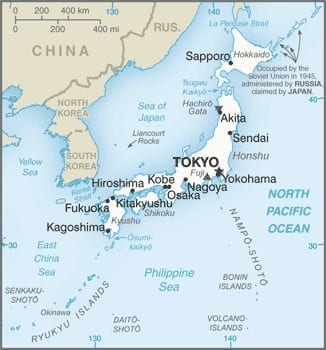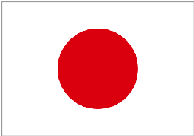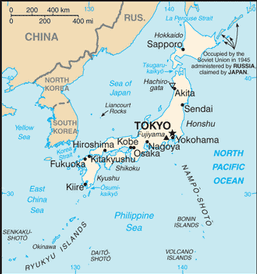Internet Domain: .jp
International Dialing Code: +81
| Location and Size | Credit and Collections |
| Government | Risk Assessment |
| Legal Systems | Business Climate |
| Interesting Facts | Business Protocol |
| Economy | |
| Comparative Economic Indicators |
Location and Size
Japan is located in Eastern Asia, and is comprised of an island chain between the North Pacific Ocean and the Sea of Japan, east of the Korean Peninsula. Japan’s total land area is 364,485 sq. km. (total area is $377,915 sq. km.). More than 70% of Japan consists of mountains, including more than 200 volcanoes.
Government
Japan has a parliamentary government with a constitutional monarchy:
Branches:
- Executive: Chief of state Emperor NARUHITO (since 2019); head of government Prime Minister Shinzo ABE (since 2013); cabinet appointed by the prime minister
- Legislative: Bicameral; House of Councilors and House of Representatives
- Judicial: Supreme Court (chief justice is appointed by the monarch after designation by the cabinet; all other justices are appointed by the cabinet)
Legal System
Japan’s legal system is based on German model; also reflects Anglo-American influence and Japanese traditions, including judicial review of legislative acts in the Supreme Court.
Japan has accepted compulsory International Court of Justice (ICJ) jurisdiction with reservations. (What does this mean?)
Interesting Facts About Japan
- Raw horse meat is a popular food in Japan.
- A nice musk melon may sell for more than 300 USD.
- Japan is the world’s largest consumer of Amazon Rain Forest timber.
- There are 1,500 earthquakes every year.
- The average life expectancy in Japan is 4 years longer than in the United States.
- “Geisha” means “person of the arts” and the first geisha were men.
Economy
In the years following World War II, government-industry cooperation, a strong work ethic, mastery of high technology, and a comparatively small defense allocation (1% of GDP) helped Japan develop a technologically advanced economy. Today, measured on a purchasing power parity basis, Japan is the third-largest economy in the world after the US and China; measured by official exchange rates, however, Japan is the second largest economy in the world behind the US.
Two characteristics of the post-war economy were: (1) the close interlocking structures of manufacturers, suppliers, and distributors, known as keiretsu; and (2) the guarantee of lifetime employment for a substantial portion of the urban labor force. Both are now eroding under the pressures of global competition and domestic demographic change.
The government continues to focus on the economy and lowering Japan’s government debt. Japan is making progress on ending deflation due to a weaker yen and higher energy costs, but reliance on exports to drive growth and an aging, shrinking population post other major long-term challenges for the economy.
Leading Markets (2017): US 19.4%, China 19%, South Korea 7.6%, Hong Kong 5.1%, Thailand 4.2%
Leading Exports – Commodities: Transport equipment, motor vehicles, semiconductors, electrical machinery, chemicals
Leading Suppliers (2017): China 24.5%, US 11%, Australia 5.8%, South Korea 4.2%, Saudi Arabia 4.1%
Leading Imports – Commodities: Machinery and equipment, fuels, foodstuffs, chemicals, textiles, raw materials
Top Industries: Automobiles, electronic equipment, machine tools, steel and nonferrous metals, ships, chemicals, textiles, processed foods
Top Agricultural Products: Rice, sugar beets, vegetables, fruit; pork, poultry, dairy products, eggs; fish
Comparative Economic Indicators – 2019
| Japan | South Korea | North Korea | Russia | China | USA | |
| Population* (millions) | 126.16 | 51.41 | 25.38 | 142.12 | 1,384.68 | 329.25 |
| Population growth rate* (%) | -0.24 | 0.44 | 0.52 | -0.11 | 0.37 | 0.8 |
| Literacy (%) | 99.0 | 97.97 | 100.0 | 99.7 | 96.4 | 99.0 |
| Unemployment rate (%) | 2.9 | 3.7 | 25.6 | 5.2 | 3.9 | 4.4 |
| Inflation (%) | 0.5 | 1.9 | n/a | 3.7 | 1.6 | 2.1 |
| Population below poverty line (%) | 16.1 | 14.4 | n/a | 13.3 | 3.3 | 15.1 |
| GDP** (USD billions) | 5,443.0 | 2,035.0 | 40.0 | 4,016.0 | 23,210.0 | 19.49 |
| GDP real growth rate (%) | 1.7 | 3.1 | -1.1 | 1.5 | 6.9 | 2.2 |
| GDP per capita** (USD) | 42,900 | 39,500 | 1,700 | 27,900 | 16,700 | 59,800 |
| Public debt (% of GDP) | 237.6 | 39.5 | n/a | 15.5 | 47.0 | 78.8 |
| Exports (USD billions) | 688.9 | 577.4 | 45.82 | 353.0 | 2,216.0 | 1,553.0 |
| Imports (USD billions) | 644.7 | 457.5 | 43.75 | 238.0 | 1,740.0 | 2,361.0 |
| Reserves of foreign exchange and gold (USD trillions) | 1,264.0 | 389.2 | n/a | 432.7 | 3,236.0 | 123.3 |
| Currency | Yen JPY |
Won KRW |
WON KPW |
Rouble RUB |
Yuan Renminbi CNY |
Dollar USD |
| Exchange rate (per USD) 8/12/2019 | 105.38 | 1,218.45 | 900.06 | 65.55 | 7.05 | n/a |
| Exchange rate (per EUR) 8/12/2019 | 118.15 | 1,366.7 | 1,009.48 | 73.48 | 7.91 | 0.89 |
*December 2018 estimates
**PPP – Purchasing Power Parity
Credit and Collections
Dispute Resolution
Japan’s civil courts enforce property and contractual rights and do not discriminate against foreign investors. Like the courts in many other countries, Japanese courts move rather slowly and experience has shown them ill-suited for litigation of business disputes. Japanese courts lack powers to compel witnesses to testify or a party to comply with an injunction. Timely temporary restraining orders and preliminary injunctions are difficult to obtain.
Filing fees are based on the amount of the claim, rather than a flat fee. Lawyers usually require large up-front payments before filing a lawsuit. Contingency fees are relatively uncommon. A losing party can delay execution of a judgment by appealing. In appeals to higher level courts, additional witnesses and other evidence may be allowed.
Japan’s Alternative Dispute Resolution (ADR) law provides a legal framework for arbitration, including international commercial arbitration. Foreign lawyers qualified under Japanese law can represent parties in ADR proceedings taking place in Japan in which one of the parties is foreign or foreign law is applicable, at least to the extent such representation is not inconsistent with Japanese law. Japan is a member of the 1958 New York Convention on the Recognition and Enforcement of Foreign Arbitration Awards. Nevertheless, Japan is considered an inhospitable forum for international commercial arbitration.
Courts have the power to encourage mediated settlements and there is a supervised mediation system. However, this process is often time-consuming and judges transfer frequently, so continuity is often lost. As a result, it is common for companies to settle cases out of court.
Risk Assessment
Coface Country Rating: A1 ” The political and economic situation is very good. A quality business environment has a positive influence on corporate payment behavior. Corporate default probability is very low on average.
Coface Business Climate Rating: A1 ” same as Country Rating (above)
According to Coface, some of Japan’s strengths include: diversified exports to other Asian economies; public sector debt underpinned by domestic savings; Advance in R&D.
Japan’s weaknesses: Rapidly aging population with virtually no immigration; high proportion of workers without steady jobs; low productivity of small and medium-sized companies.
Credendo Political Risk: 1 ” lowest risk (1 to 7)
Credendo Commercial Risk: A ” lowest risk (A, B, C)
Business Climate
Market Access: The export-oriented Japanese economy has long benefited from global trade, although non-tariff barriers linger, hurting overall trade freedom.
Transparency of Regulatory System: The Japanese economy suffers from over-regulation, underlies many market access and competitive problems faced by foreign companies in Japan.
Intellectual Property Rights: Japan maintains a strong intellectual property rights regime, but there are costs and procedures of which prospective investors should be aware. Companies doing business in Japan are encouraged to be clear about all rights and obligations with respect to IPR in any trading or licensing agreements. Explicit arrangements and clear understanding between parties will help to avert problems resulting from differences in culture, markets conditions, legal procedures, or business practices.
The IPR rights holder must register patents and trademarks in Japan. Filing the necessary applications requires hiring a Japanese lawyer or patent practitioner registered in Japan.
Conversion and Transfer Policies: Generally, all foreign exchange transactions to and from Japan — including transfers of profits and dividends, interest, royalties and fees, repatriation of capital, and repayment of principal — are freely permitted.
Economic Freedom: According to the Heritage Foundation’s 2019 Index of Economic Freedom, Japan’s economic freedom score is 72.1, making its economy the 30th freest in the 2019 Index. Japan is ranked 8th out of 43 countries in the Asia”Pacific region.
Corruption: The direct exchange of cash for favors from government officials in Japan is extremely rare. However, the web of close relationships between Japanese companies, politicians, government organizations, and universities fosters an inwardly cooperative business climate that tends to award contracts, positions, etc. within a tight circle of local players.
Expropriation and Compensation: Expropriation or nationalization of foreign investments is extremely unlikely.
Political Violence: Political violence is rare in Japan.
Business Protocol in Japan
The concept of face is crucial in Japanese society. Face is a mark of personal dignity and means having high status with one’s peers. The Japanese will try never to do anything to cause loss of face. Therefore, they do not openly criticize, insult, or put anyone on-the-spot. Face can be lost, taken away, or earned.
Harmony is the guiding philosophy for the Japanese in family, business settings and society as a whole.
The Japanese understand that it is very difficult for foreigners to work in Japan. They will not expect you to speak or read Japanese, or be conversant with their strict cultural nuances and protocol. Mistakes are allowed as long as genuine respect is shown at all times.


